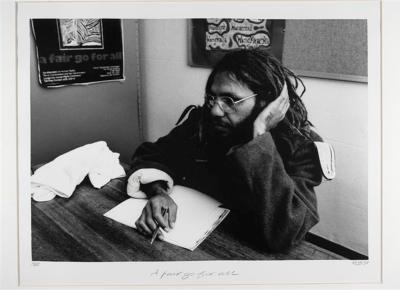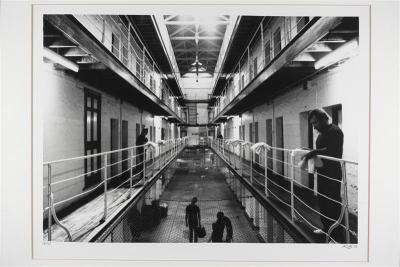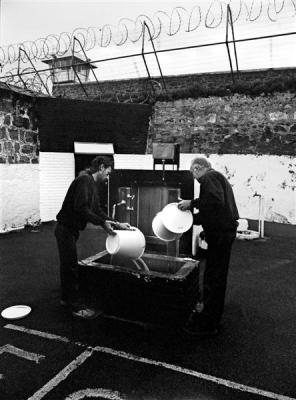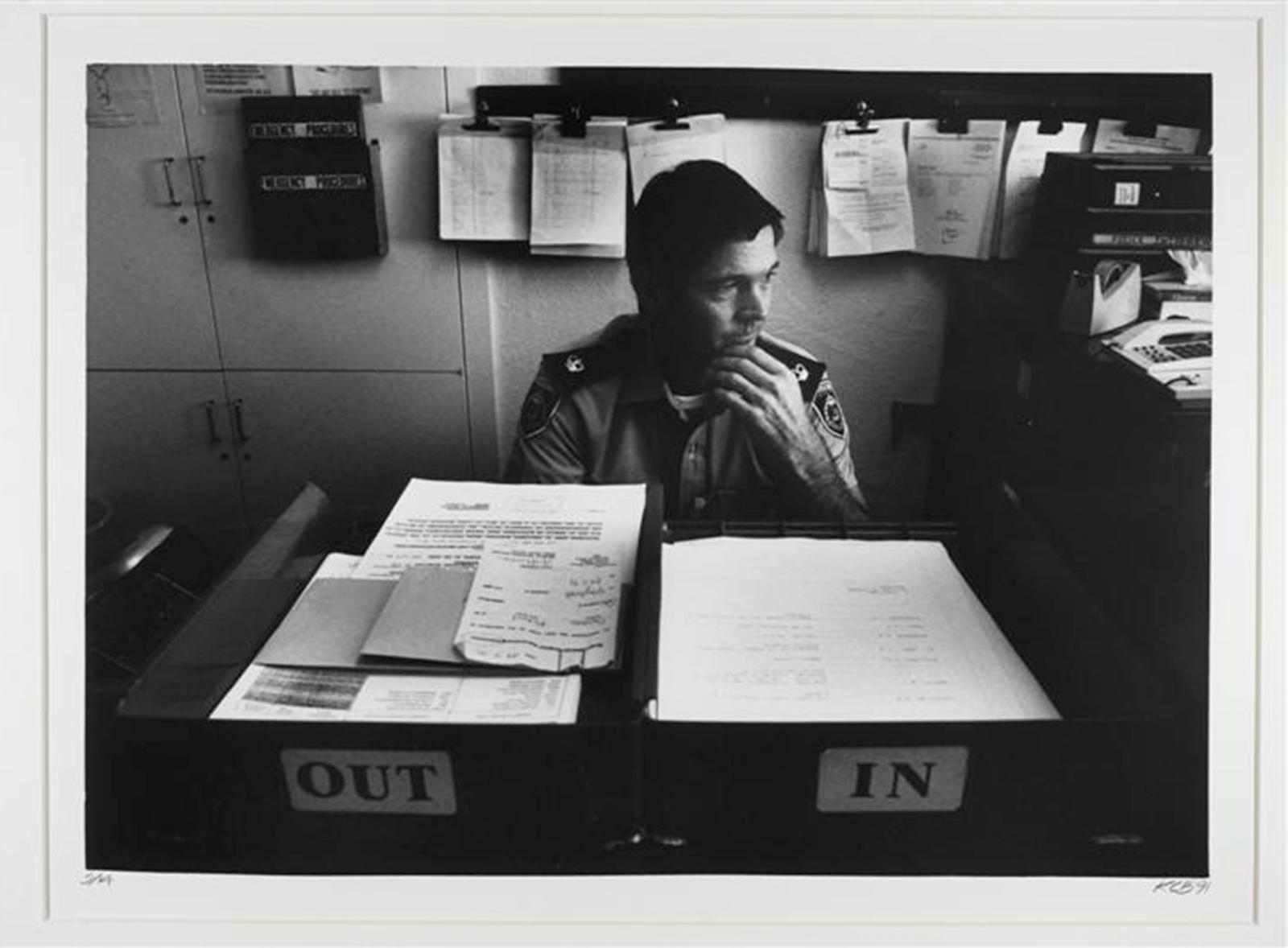UNTITLED: INFORMATION CENTRE, 12.00PM, IN/OUT TRAYS
1991Black and white, landscape photograph of a seated Prison Officer, with elbow resting on a desk in the foreground, and an arm raised to support his chin. The seated Officer is wearing a short-sleeved shirt, unbuttoned at the neck revealing a white t-shirt underneath. Two 'OUT' and 'IN' trays are in the foreground, each holding documents. The background shows an office lined by cupboards, an Emergency Procedure Manual, and seven clips hanging from the wall each holding A4 documents. Also in the background along the right side of the image is a white pushbutton telephone, cello tape dispenser, box of tissues and stack of books one labelled 'Police Interview'. On the reverse side of the photograph is an adhesive label, printed with, 'Photograph by KCB', '24.5.91 5/14' and 'Information Centre, 12.00pm, In/Out trays'. A copyright stamp is in the top right hand corner.
In 1991 professional photographer Karin Calvert took a series of black and white photographs inside the Prison while it was still operational. These photographs were taken over several weeks in June 1991, five months before Fremantle Prison closed as Western Australia’s maximum security prison.
Details
Details
Karin Calvert was commissioned to document everyday life inside the Prison by the State Government, to record the facility and its customs before it ceased to operate as a place of incarceration. These striking images show more than everyday life, they offer a rare view of people’s life and the stark conditions inside Fremantle Prison. Karin Calvert captured inmates, staff and educators going about their daily routines. This photographic series encapsulates one of the best records of everyday life inside Fremantle Prison. The collection consists of 103 original prints signed by the author and a larger selection of negatives.
The average daily routine of inmates altered little over Fremantle Prison’s history. The day commenced when the night officer rang a hand bell throughout the divisions at 6.45am to indicate that the cells would be unlocked in 15 minutes. After the prisoners had dressed and prepared for the day, officers would systematically unlock each cell until they reached the end of their assigned landing. The released prisoners, who had been locked in their cells for the past fourteen hours, were required to remain standing outside the cell door until told to ‘file off’. Once the order was given they would move away, carrying their toilet bucket and water bucket, into the exercise yards. The prisoners would move down into the back end of the yard where they would empty their toilet buckets into the septic traps, leaving the buckets on the white lines nearby for hosing and disinfecting. The prisoners would then be able to clean their teeth, shave and wash their face and hands. On Monday, Wednesday or Friday they would also be filed off to the shower shed to bathe. The prisoners would then return to their cells for breakfast, picking up their meal from the food trolley before being locked back in their cells. At 8am, the cells would be unlocked again and the prisoners would return to the yards, where they would be marshalled for work in the Prison workshops. Work began at 8.30am, and stopped at 12 noon for lunch in the exercise yards. After lunch, prisoners returned to the workshops until 3.30pm. After work, they returned to the exercise yards where they picked up their toilet buckets and lined up for dinner. They were then locked in their cells around 4pm, with lights out at 11pm. The weekend routine differed, with the wakeup call at 7.45am, no work in the workshops, and the whole day spent in the exercise yards.
These professional photographs, which record everyday life at Fremantle Prison just prior to its closure in 1991, are a rare example of life inside a maximum security facility in the early 1990s. As further evidence of how this convict site has survived through continued use into the modern era, these images have international historic and social significance. Their excellent condition, provenance, and high aesthetic value add to their overall significance, expressing authentic prison experiences at this Word Heritage Listed site.
Open in Google Maps
Nearest geotagged records:
- PHOTOGRAPH OF CATHOLIC CHAPEL AFTER 1988 RIOT (0km away)
- AD REM PRISON NEWSLETTER (0km away)
- CONCERT PROGRAMME (0km away)
- IMAGE OF CHRISTMAS FESTIVITIES (0km away)
- ENTRANCE TO FREMANTLE PRISON (0km away)
- IMAGE OF SALLY PORT (0km away)
- IMAGE OF THE MAIN CELL BLOCK (0km away)
- GATEHOUSE/RECEPTION (0km away)
- IMAGE OF BAKING BREAD (0km away)
- PHOTOGRAPH OF PRISON LIBRARY (0km away)
Nearby places: View all geotagged records »




